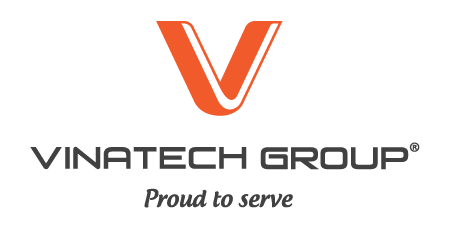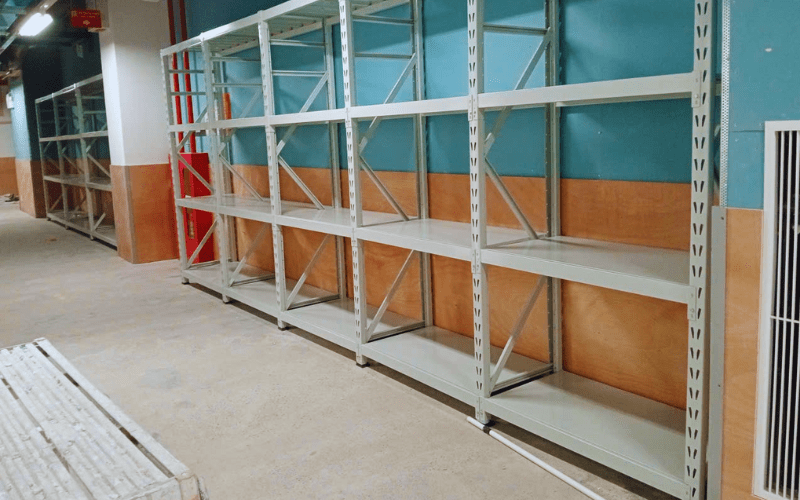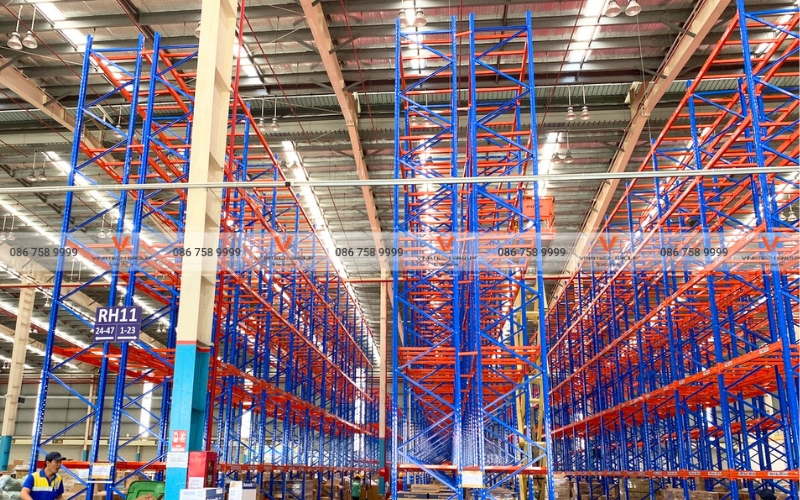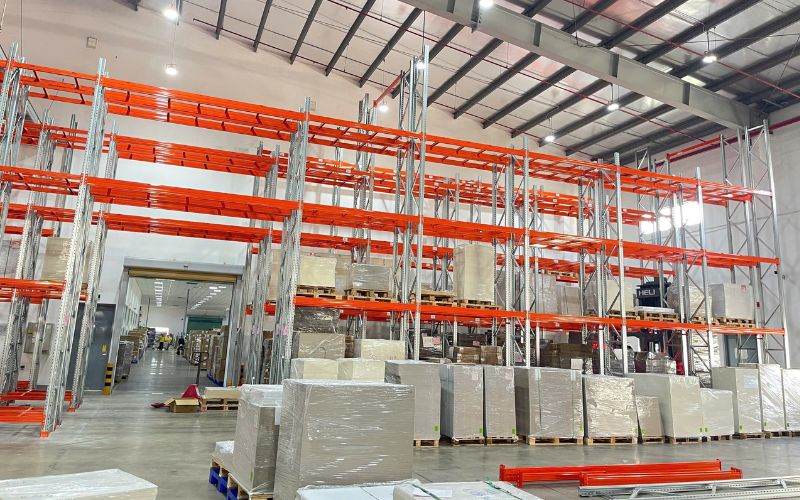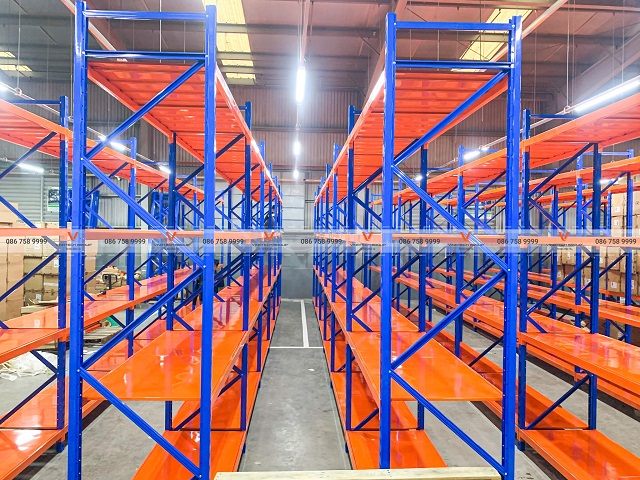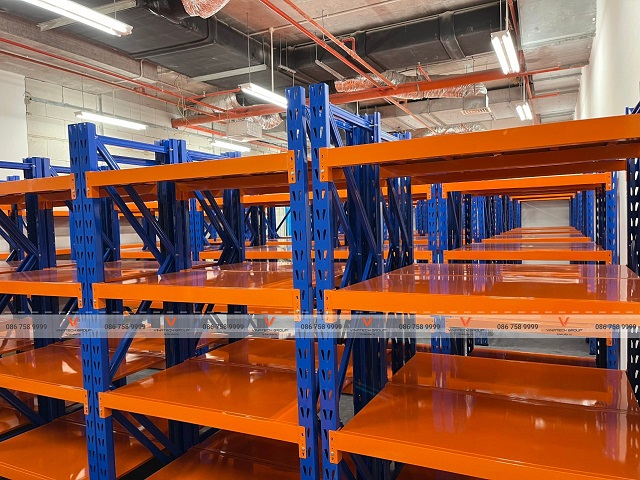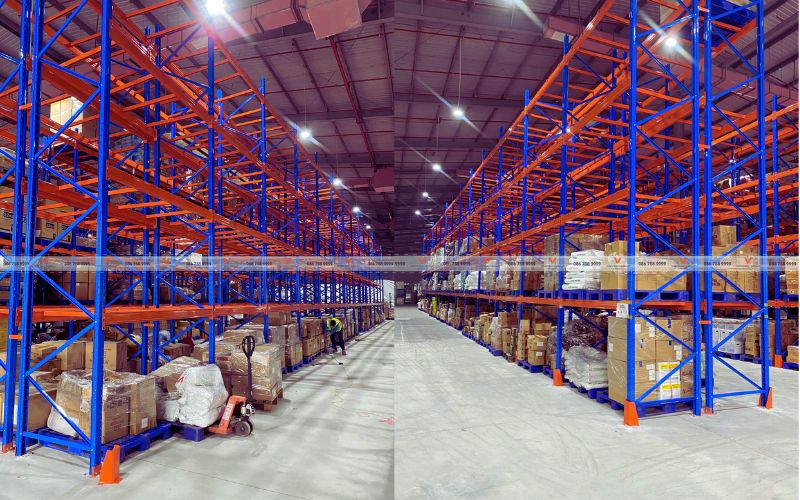Dry goods warehouse racking systems are essential infrastructure for enterprises operating in food distribution, retail, and manufacturing sectors. Unlike fresh or perishable products, dry goods require specialized storage solutions maintaining product quality while optimizing space utilization and operational efficiency. Understanding proper racking selection and warehouse configuration ensures long-term product preservation, efficient inventory rotation, and cost-effective operations.join Vinatech Group to explore pricing information!
Understanding Dry Goods Warehouse Requirements
Dry goods warehouses store non-perishable products including grains, cereals, pasta, canned foods, bottled beverages, packaged snacks, spices, flour, sugar, coffee, tea, and various shelf-stable products. These facilities must maintain specific environmental conditions preventing moisture contamination, pest infestation, and product degradation while supporting high-volume distribution operations.
Environmental Control Priorities:
Temperature stability between 10-25°C prevents product deterioration and extends shelf life. Humidity levels must remain below 60% preventing moisture absorption causing mold growth, clumping, or packaging damage. Proper ventilation systems maintain air circulation reducing condensation risks while adequate lighting enables accurate inventory management and quality inspections.
Storage Duration Considerations:
Dry goods typically have extended shelf lives ranging from several months to multiple years depending on product type and packaging. Racking systems must accommodate long-term storage while enabling systematic First-In-First-Out (FIFO) rotation ensuring products ship before expiration dates. Proper date coding visibility and accessible placement facilitate effective inventory turnover management.
Optimal Racking Systems for Dry Goods Warehouses
Pallet Racking
Pallet Racking represents the most flexible configuration for dry goods warehouses handling diverse product ranges with varying SKUs. This system provides 100% direct pallet accessibility enabling immediate product retrieval without moving other pallets, critical for maintaining FIFO rotation and preventing expired product losses.
Technical Specifications:
- Load capacity: 1,000-3,000 kg per pallet position
- Height configurations: 4-12 meters utilizing vertical space
- Aisle width: 2.8-3.5 meters accommodating standard forklifts
- Adjustment flexibility: Beam levels easily reconfigure for different pallet heights
Operational Advantages:
Quick picking speeds support high-velocity distribution operations with multiple daily shipments. Individual pallet access enables accurate inventory counting and quality inspections without disrupting surrounding merchandise. Flexible configurations adapt to seasonal volume fluctuations and changing product assortments. Compatible with standard warehouse equipment eliminating specialized machinery investments.
Drive-In Racking
Drive-In racking maximizes storage density for dry goods with uniform SKUs and large quantities per product type. This system eliminates aisles between rack rows, with forklifts driving directly into the structure for pallet placement and retrieval, achieving 75-85% space utilization versus 40-50% with Selective systems.
Configuration Details:
- Depth capacity: 5-10 pallets deep per lane
- Load capacity: 1,000-3,000 kg per pallet
- Lane organization: Dedicated channels per product SKU
- Operating principle: LIFO (Last In, First Out) or FIFO with Drive-Through design
Application Scenarios:
Ideal for bulk dry goods like rice, wheat flour, sugar, or canned products where enterprises maintain large quantities of individual items. Reduces refrigeration costs in climate-controlled facilities by minimizing aisle space. Suits seasonal products with synchronized production and distribution cycles. Best for items with extended shelf lives minimizing expiration concerns.
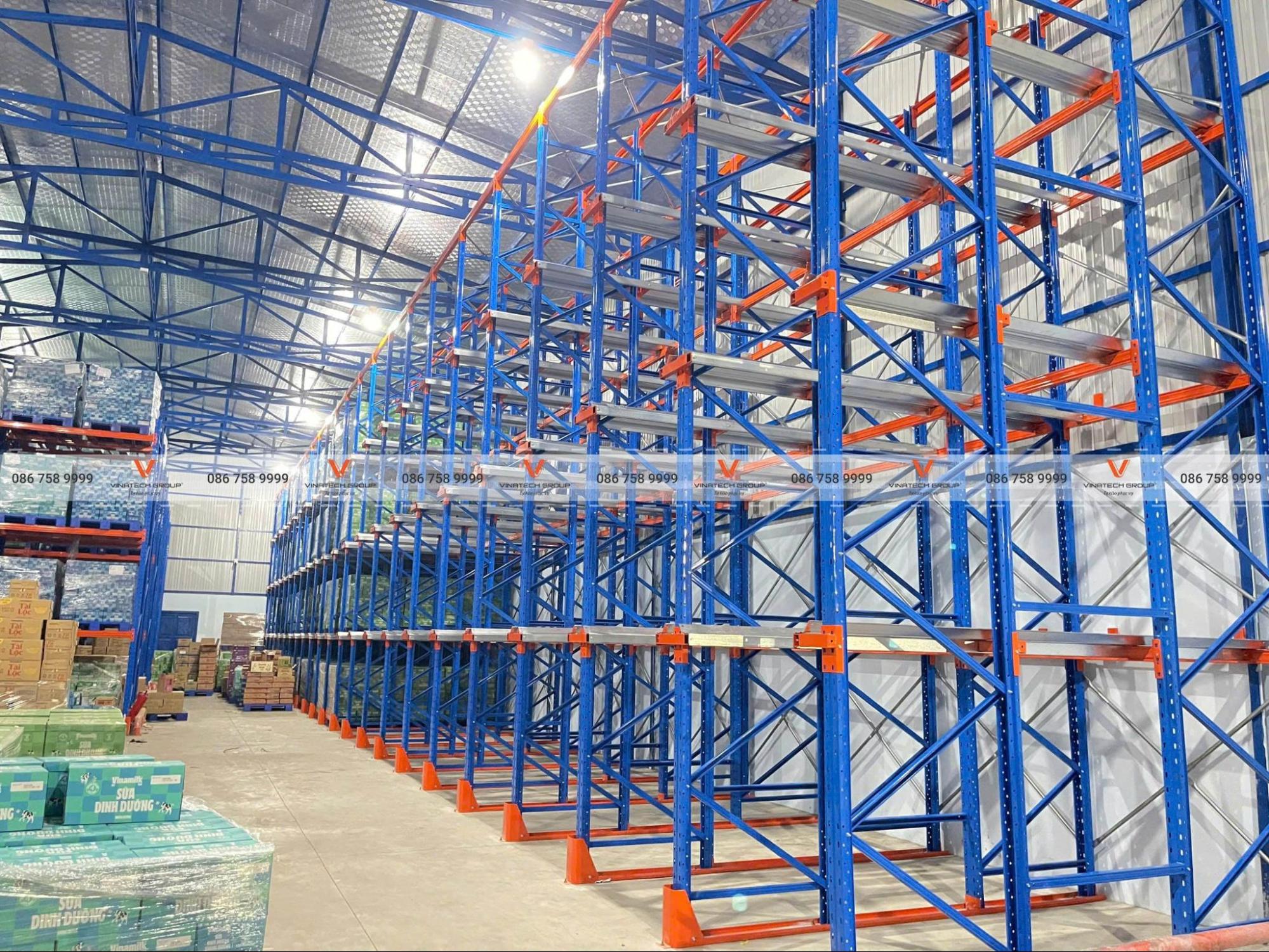
Double Deep Racking
Double Deep racking provides middle-ground solutions balancing storage density and accessibility. Pallets position two-deep on each side of aisles, increasing capacity 30-40% versus Selective while maintaining reasonable retrieval flexibility.
System Characteristics:
- Accessibility: 50% of pallet positions directly reachable
- Space savings: Reduces aisle requirements by half
- Equipment requirements: Specialized double-deep reach trucks
- Product suitability: Medium SKU diversity with moderate turnover
Strategic Implementation:
Front positions store fast-moving products requiring frequent access while rear positions accommodate slower-turnover reserve inventory. Supports zone picking strategies with high-velocity items in accessible locations. Enables warehouse expansion without facility enlargement. Reduces forklift travel distances improving productivity.
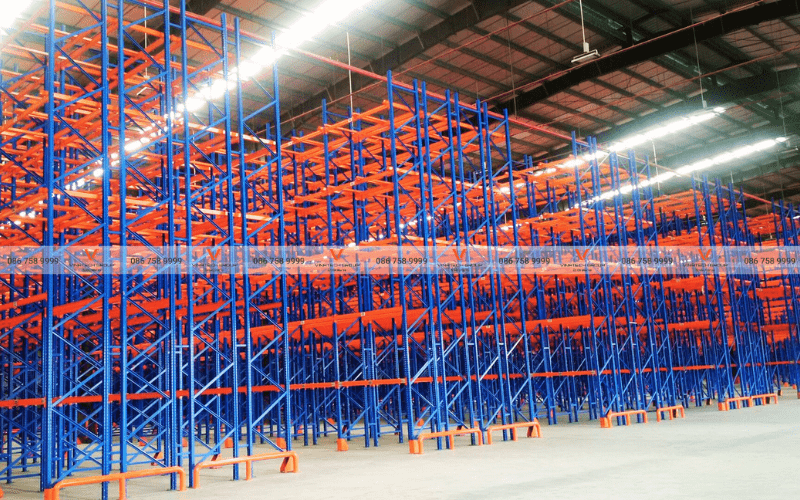
Medium-Duty Shelving
For dry goods warehouses handling case picking, small packages, or direct-to-consumer fulfillment, Medium-duty Shelving provides ergonomic, accessible storage for items weighing 200-500 kg per level.
Design Features:
- Multi-tier configurations: 3-6 adjustable shelf levels
- Manual picking: Ergonomic heights reducing worker fatigue
- Carton storage: Individual boxes and cases without palletization
- Visual management: Open design enabling inventory visibility
Ideal Applications:
E-commerce fulfillment centers shipping individual consumer packages. Retail distribution centers preparing store replenishment orders. Food service suppliers assembling restaurant orders. Specialty food distributors handling diverse product assortments.
Pallet Selection for Dry Goods Storage
Wooden Pallets:
Traditional wooden pallets offer economical initial investment suitable for standard dry goods warehousing. However, wood absorbs moisture potentially contaminating hygroscopic products like flour, sugar, or powdered goods. Susceptible to pest infestation requiring fumigation for international shipments. Limited reusability with average lifespans of 3-5 years under normal conditions.
Plastic Pallets:
Hygienic plastic pallets prevent moisture absorption and pest harboring, ideal for food-grade dry goods requiring strict sanitation. Withstand repeated washing and sanitization maintaining cleanliness standards. Higher initial cost offset by 10+ year operational lifespans. Lightweight construction reduces forklift energy consumption and worker injury risks.
Steel Pallets:
Heavy-duty steel pallets support maximum load capacities for dense products like canned goods, bottled beverages, or bagged grains. Fire-resistant properties enhance warehouse safety in high-volume facilities. Antibacterial powder coating maintains sanitation standards. Highest durability with 15-20 year service lives despite premium pricing.
Warehouse Layout Optimization Strategies
Zone Configuration:
Fast-moving products position near shipping docks minimizing travel distances and accelerating order fulfillment. Seasonal items occupy flexible zones expanding or contracting based on demand cycles. Slow-moving or excess inventory utilizes high-density storage maximizing space efficiency. Quarantine zones isolate damaged or recalled products preventing accidental shipment.
Aisle Planning:
Primary aisles provide main traffic routes for high-velocity product movement connecting receiving and shipping areas. Secondary aisles enable access to specific rack sections supporting picking operations. Cross aisles facilitate equipment navigation and emergency egress. Aisle widths balance accessibility requirements with space utilization objectives.
Environmental Zones:
Dry ambient areas maintain standard temperature and humidity for shelf-stable products. Climate-controlled zones provide enhanced environmental control for moisture-sensitive items like powdered products, spices, or crackers. Segregated areas isolate strong-odor products preventing cross-contamination with odor-absorbing items.
Inventory Management Best Practices
FIFO Rotation Systems:
Clear date coding on pallet positions and shelving locations ensures oldest inventory ships first. Visual management systems like color-coded labels or digital displays indicate production dates and expiration deadlines. Regular cycle counting verifies physical inventory matches system records preventing expired product losses. Automated WMS alerts flag approaching expiration dates triggering promotional pricing or disposition decisions.
Quality Control Protocols:
Incoming inspection verifies packaging integrity, proper labeling, and appropriate product conditions before acceptance. Periodic quality audits randomly sample stored products checking for pest evidence, package deterioration, or environmental damage. Temperature and humidity monitoring with automated alerts prevent environmental excursions compromising product quality.
Supporting Equipment Requirements
Counterbalance Forklifts:
Standard 2,000-3,000 kg capacity forklifts serve Selective racking operations in standard aisle widths. Three-wheel electric models provide maneuverability in tighter spaces while maintaining lifting capacity. Cushion tires suit smooth warehouse floors while pneumatic tires accommodate outdoor loading areas.
Reach Trucks:
Specialized reach trucks with extendable forks access Double Deep racking rear positions. Narrow chassis widths operate in reduced aisle spaces maximizing facility utilization. Elevated operator positions improve visibility during high-level stacking operations.
Order Pickers:
Personnel lifts enable manual picking from upper storage levels in medium-duty shelving zones. Elevated platforms position workers at ergonomic heights reducing reaching and bending. Load capacities accommodate both operator and picked merchandise weights.
Vinatech Group: Dry Goods Warehouse Expertise
With 14+ years serving Vietnam’s food distribution and retail sectors, Vinatech Group delivers comprehensive dry goods warehouse solutions optimizing storage capacity, operational efficiency, and product quality preservation.
Our Advantages:
Premium steel construction with food-grade powder coating meeting sanitation standards. Custom design services analyzing product characteristics, turnover rates, and space constraints. Nationwide installation with minimal operational disruption. Extended warranty programs with periodic maintenance inspections. Competitive factory-direct pricing eliminating intermediary markup.
Service Commitments:
Complimentary facility assessment and layout optimization. 2D/3D warehouse visualization with capacity calculations. Professional installation supervision ensuring structural integrity. Staff training on safe operation and maintenance procedures. 24/7 technical support addressing operational issues.
Vinatech Group – Vietnam’s leading warehouse racking and smart storage solution provider
Hotline: +84 86 758 9999
Email: info@vinatechgroup.vn
Website: vinatechgroup.vn
Offices:
- Hanoi: 15F TTC Building, 19 Duy Tan St., Dich Vong, Cau Giay
- Da Nang: 219-223 Pham Hung St., Hoa Xuan, Cam Le
- Ho Chi Minh City: C2-7 N7 Road, Tan Phu Trung Industrial Park, Cu Ch
